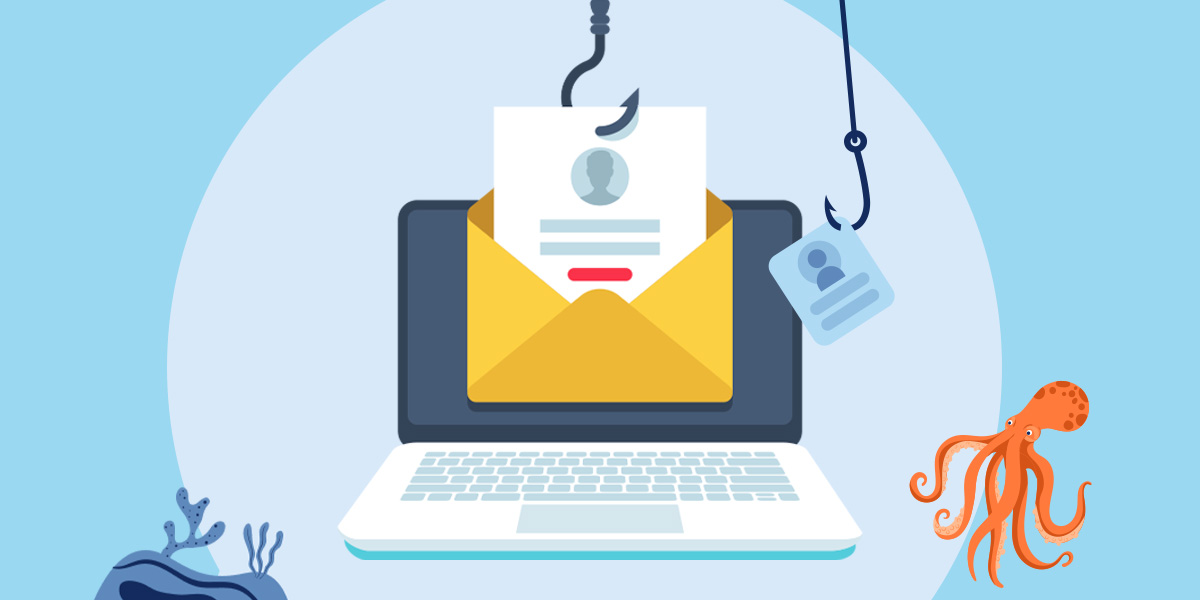


What Is Spear Phishing?



In 2024, phishing accounted for 73% of all data breaches in the United States. Spear phishers target organizations or individuals with personalized emails, intending to steal sensitive information. Once the victim completes the intended action, such as clicking a link or attachment, the attacker can steal login credentials, infect the target's device with malware or enter a network undetected — leading to devastating effects for that person or organization.
In our guide, we'll discuss this type of cyberattack, the impact of spear phishing campaigns and how to implement cybersecurity training to protect your organization.
How Does Spear Phishing Work?
Spear phishing works by carefully researching the target and crafting an email that appears to come from a trusted sender in the target's network. Social engineering techniques in cyberattacks are becoming more prevalent, as attackers exploit this research to urge victims to click on a malicious link or attachment more easily.
Spear Phishing vs. Phishing
While both spear phishing and standard phishing trick targeted users into divulging sensitive information, spear phishing involves more effort from the attacker. Spear phishers usually conduct research to understand their target and send emails that contain just enough information to make it seem like they're a legitimate sender.
In contrast, phishing campaigns have no specific target. Attackers typically cast a wider net, sending thousands of phishing emails to an email contact list.
Spear Phishing vs. Whale Phishing
Whale phishing is a form of phishing that prioritizes C-level targets. It uses the same personalized strategy as spear phishing, except it specifically targets higher-level management to expose financial and confidential information. Whaling attacks aim to extract more valuable, classified information, which can magnify the damaging impact on an organization.
Techniques and Tactics Used in Spear Phishing
Spear phishing attackers will take the time to understand the target organization or person, sending out personalized messages they think will work best. Common techniques include:
- Impersonation: Attackers often impersonate high-ranking officials or trusted colleagues to create a sense of urgency and authority. Spear phishers frequent social media sites to gather personal information about their target. They might map out the target's network of personal contacts, allowing them to craft a more trustworthy message.
- Urgency and fear: Emails may include phrases like "immediate action required" or "your account will be suspended," encouraging the target to respond quickly without thoroughly checking the email.
- Customized content: Attackers research their targets to include specific details, such as recent projects or shared contacts, that make the email more believable.
- Fake links and attachments: Emails often contain malicious links or attachments disguised as legitimate documents, such as putting them in PDF format or making them appear as Word documents.
- Leveraging artificial intelligence (AI): The more sophisticated attackers might also use machine learning algorithms to scan massive amounts of data and identify high-level individuals they most want to target. AI systems can also create convincing phishing emails tailored to individual targets, increasing the volume and effectiveness of spear phishing campaigns.
Spear Phishing Examples
Spear phishing campaigns can take many forms, depending on the industry. Examples include:
- Tech: A large tech company receives an email that appears to come from a trusted partner. The email contains a link to a fake document that, when clicked, installs malware on the company's network, allowing attackers to steal sensitive data.
- Finance: Another scenario involves an employee at a financial institution receiving an email that looks like it's from the CEO requesting an urgent wire transfer to a new vendor. The employee, believing the request to be legitimate, initiates the transfer, resulting in a significant financial loss.
- Healthcare: Healthcare organizations are increasingly targeted by spear phishers. In this type of spear phishing attack, a provider might receive an email disguised as a communication from a government health agency. The email requests the employee to verify their information, leading to a breach of patient data when they inadvertently provide sensitive details.
The Impact of Spear Phishing Campaigns

Spear phishing can significantly impact individuals and organizations, potentially leading to the following consequences:
Financial Losses
Spear phishing can cause significant financial losses, whether through unauthorized transactions, wire transfer scams, data theft or extortion. Attackers might gain access to bank accounts or credit card information, trick employees into wiring them large sums of money or steal sensitive data and threaten to release it publicly unless a ransom is paid.
Reputational Damage
Spear phishing can result in the loss of customers, with news of a data breach or financial fraud leading to a decline in business and stake holder trust. These attacks can also portray an organization as vulnerable to cyberattacks, damaging its brand image. Spear phishing can also attract negative media attention, further harming the organization's reputation.
Risks of Sensitive Data Exposure
Spear phishing can compromise sensitive data, leading to severe consequences for both individuals and organizations. Stolen personal information can be used for identity theft, resulting in legal issues and financial losses. Attackers can also steal trade secrets, designs or other confidential information — giving competitors an unfair advantage. Spear phishing can also lead to compliance violations and hefty penalties, as data breaches may violate privacy regulations.
Spear Phishing Prevention Tips
Spear phishing can have significant long-term effects on an organization, making it essential to implement prevention strategies:
1. Security Awareness Training
The importance of employee training in cybersecurity cannot be overstated. Your employees should know how to recognize various types of phishing attacks, such as identifying email IDs before replying to emails sent from outside the organization or knowing to validate URLs before clicking on links.
Phishing simulations allow employees to practice what they learn from security awareness training. You can then measure how well employees understand these attacks and use that data to improve training.
2. Detection Tools and Technologies
Various tools and technologies can help prevent spear phishing attacks, such as email security gateways that analyze incoming emails for phishing attempts and malicious links. Multi-factor authentication (MFA) can also add a layer of security, making it harder for attackers to gain unauthorized access even if your credentials are compromised. URL and link scanners can also identify malicious links in emails before users click on them.
3. Cybersecurity Policies
Create a comprehensive cybersecurity policy that outlines your security goals, roles and responsibilities. The policy should include guidelines for acceptable use, data protection, incident response and remote work. It should also include protocols for securely handling, storing and transmitting data to prevent cyberattacks.
4. Regular Maintenance
Regular maintenance is critical in identifying and reporting suspicious emails to prevent phishing. Make sure that your remote services, VPNs and MFA solutions are fully patched, configured and integrated to avoid phishing attacks. Security, network and application logs should also be regularly monitored for suspicious activity.
Conduct ongoing security awareness training to educate employees on the latest cybersecurity threats, including testing and simulations to reinforce these lessons.
Turn to Phin Security for Spear Phishing Prevention Solutions
Understanding the dangers of spear phishing can help your organization prevent data breaches. At Phin Security, we provide automated, hands-off training to help you prevent cyberattacks. Our innovative solutions, including customized training programs, can fortify your defense against spear phishing attacks. These interactive and short lessons engage employees, helping them more easily retain information.
With our effective, easy-to-manage security awareness training, you can save time, money and energy while your organization becomes more secure. Contact us today or start a free trial to explore our spear phishing prevention solutions.







Leave a comment: